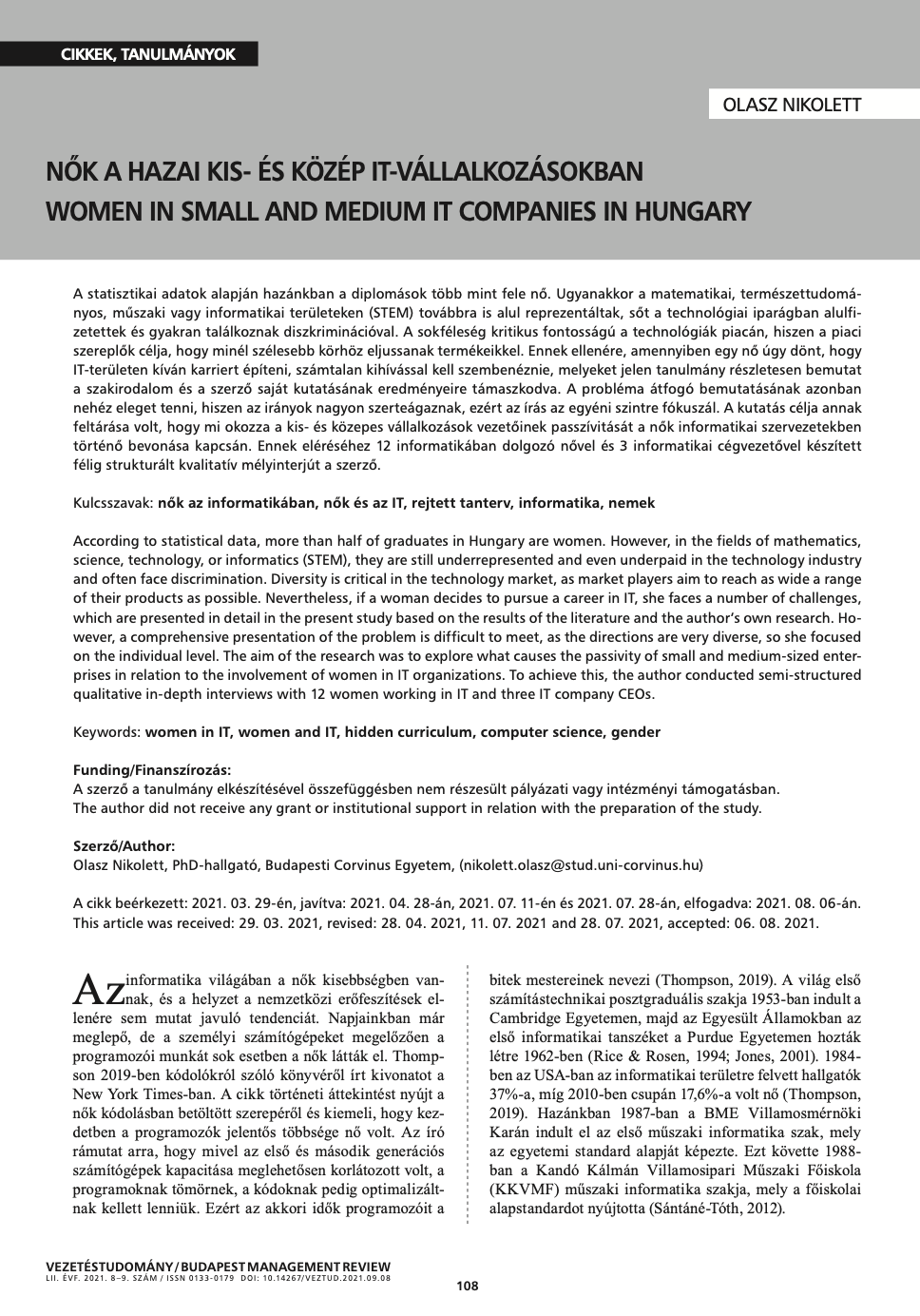Nők a hazai kis- és közép IT-vállalkozásokban
DOI:
https://doi.org/10.14267/VEZTUD.2021.09.08Keywords:
women in IT, women and IT, hidden curriculum, computer science, genderAbstract
According to statistical data, more than half of graduates in Hungary are women. However, in the fields of mathematics, science, technology, or informatics (STEM), they are still underrepresented and even underpaid in the technology industry and often face discrimination. Diversity is critical in the technology market, as market players aim to reach as wide a range of their products as possible. Nevertheless, if a woman decides to pursue a career in IT, she faces a number of challenges, which are presented in detail in the present study based on the results of the literature and the author’s own research. However, a comprehensive presentation of the problem is difficult to meet, as the directions are very diverse, so she focused on the individual level. The aim of the research was to explore what causes the passivity of small and medium-sized enterprises in relation to the involvement of women in IT organizations. To achieve this, the author conducted semi-structured qualitative in-depth interviews with 12 women working in IT and three IT company CEOs.
Downloads
References
Arenius, P., & De Clercq, D. (2005). A network-based approach on opportunity recognition. Small Business Economics, 24(3), 249–265. https://doi.org/10.1007/s11187-005-1988-6
Bernstein, C. (2020). Biological Sex, Gender Roles and Social Support in South Africa: The Influence of Positive and Negative Sex Roles on Perceptions of Social Support. Gender & Behaviour, 18(2), 15521– 15533. http://eds.a.ebscohost.com/eds/pdfviewer/pdfviewer?vid=2&sid=f858caf6-17e8-47ef-8535-c55cbfc89148%40sdc-v-sessmgr03
Coffey, A. & Atkinson, P. (1996). Making sense of qualitative data. Thousand Oaks: Sage Publications.
Füleki, K., Groó, D., Kleinheincz, F. & Paksi, V. (2018). EFFORTI – Deliverable 2.2 Country Note Hungary. https://www.efforti.eu/publications/country-reports
Harvey, V., & Tremblay, D G. (2020). Women in the IT Sector: Queen Bee and Gender Judo Strategies. Employee Responsibilities and Rights Journal, 32, 197–214. https://doi.org/10.1007/s10672-020-09353-z
Jones K. S. (2001). A brief informal history of the Computer Laboratory [online]. Cambridge: University of Cambridge. https://www.cl.cam.ac.uk/events/EDSAC99/history.html
Lannert, J. & Nagy, B. (2019). A nők helyzete a magyar tudományos életben. Szociológiai Szemle, 29(4), 63-82. https://szociologia.hu/dynamic/63_82_oldal_JAV04.pdf
Martin C.L., & Dinella L.(2001). Gender-related Development. In Smelser N. J. &, Baltes P. B. (Eds.), International Encyclopedia of the Social & Behavioral Sciences (pp. 6020-6027). Oxford: Pergamon. https://doi.org/10.1016/B0-08-043076-7/01684-3
Mohr, T. S. (2014). Why Women Don’t Apply for Jobs Unless They’re 100% Qualified [online]. Harvard Business Review. https://hbr.org/2014/08/why-women-dont-apply-for-jobs-unless-theyre-100-qualified
Nagy B. (2014). Biológia vagy társadalom? – Bevezető tanulmány a nemek kérdésköréhez Kultúra és Közösség, 5(4), 95-103. http://www.kulturaeskozosseg.hu/pdf/2014/4/06.pdf
Nagy B. (2014). Háttérben: Kísérlet egy szervezeti nemi rend feltárására. Újratervezés – a nők és a műszaki tudományok 2.0. Budapest: L’Harmattan. https://www.replika.hu/system/files/archivum/replika_117-118-07_ takacs.pdf
Nagy,B.&Primecz,H.(2010).Nőkésférfiakaszervezetben. Kísérlet a mítoszok feloszlatására. Vezetéstudomány, 41(1), 2-17. https://doi.org/10.14267/VEZTUD.2010.01.01
Nimmesgern H. (2016) Why Are Women Underrepresented in STEM Fields? Women in Chemistry, 22(11), 3529-3530. https://doi.org/10.1002/chem.201600035
Paksi V. (2014). Miért kevés a női hallgató a természet- és műszaki tudományi képzésekben? Replika, 85-86(4-1), 5-130. http://real.mtak.hu/15481/1/Paksi_tordelt_ javPV.pdf
Rice, J. R.& Rosen, S. (1994). History of the Department of Computer Sciences at Purdue University [online]. Purdue University. https://web.archive.org/web/20111216124633/http://www.cs.purdue.edu/history/history.html
Sántáné-Tóth E.(2012). A számítástechnika felsőfokú oktatásának kezdetei Magyarországon. Budapest: Typotex. https://docplayer.hu/3997171-A-szamitastechnika-felsofoku-oktatasanak-kezdetei-magyarorszagon.html
Schleicher, A. (2019). PISA 2018. Insights and Interpretations. Paris: OECD Publishing. https://www.oecd.org/pisa/PISA%202018%20Insights%20and%20Interpretations%20FINAL%20PDF.pdf
Szekeres, V., Takács, E. & Vicsek, Lilla (2013). „Úristen! Te, lányként?!”: a nemek kultúrája egy felsőoktatási intézmény műszaki karain: a hallgatónők szemszögéből. Társadalmi Nemek Tudománya Interdiszciplináris eFolyóirat, 3(1), 125-144. http://acta.bibl.u-szeged.hu/64359/1/tntef_003_001_125-144.pdf
Szlávi A. (2019). Nemi sztereotípiák az informatika oktatásban [online]. https://people.inf.elte.hu/szlavi/InfoDidact19/Manuscripts/SzA.pdf
Szokolszky Á. (2004). Kutatómunka a pszichológiában. Budapest: Osiris Kiadó. https://regi.tankonyvtar.hu/hu/tartalom/tamop425/2011_0001_520_kutatomunka_a_ pszichologiaban/index.html
Thompson, C. (2019). The secret history of women in coding. The New York Times Magazine, 2019. 02. 13. https://www.nytimes.com/2019/02/13/magazine/women-coding-computer-programming.html
Trauth, E. (2002). Odd girl out: an individual differences perspective on women in the IT profession. Information Technology & People, 15(2), 98-118. https://doi.org/10.1108/09593840210430552

Downloads
Published
How to Cite
Issue
Section
License
Copyright (c) 2021 Vezetéstudomány / Budapest Management Review

This work is licensed under a Creative Commons Attribution 4.0 International License.
Authors assign copyright to Vezetéstudomány / Budapest Management Review. Authors are responsible for permission to reproduce copyright material from other sources.

